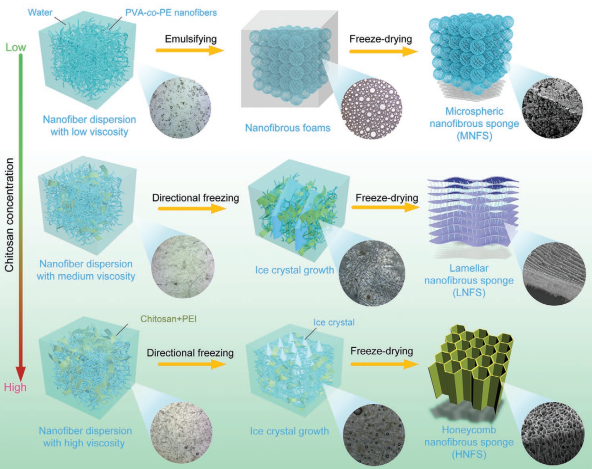Solution Viscosity-Mediated Structural Control of Nanofibrous Sponge for RNA Separation and Purification
Abstract: Engineering 3D nanofibrous monolithic materials with a controllable porous channel structure and chemical activity is promising for the rapid and efficient separation of environmentally sensitive biomacromolecules such as RNA. Herein, freeze-drying method via regulating the viscosity of nanofiber dispersions is developed to fabricate nanofibrous sponges (NFSs) with 3D structures of microsphere, lamella, and honeycomb by combining poly(vinylalcohol-co-ethylene) (PVA-co-PE) nanofibers with chitosan (CS) and polyethyleneimine (PEI) in dispersions. Among sponges, ahoneycomb nanofibrous sponge (HNFS) possesses highly oriented open-cells and optimal performance, including water permeability of 7.431 × 103 L h m−2 at 1 psi, static saturated capacity of 887.6 mg g−1, dynamic capacity of 763.2 mg g−1 at a flow rate of 1 mm min−1, and mechanical robustness, superior to reported state-ofthe-art ion-exchange chromatography materials. Furthermore, HNFS-packed chromatographic, funnel, and centrifugal columns present exceptional performance and broad applicability in rapid-separation of RNA from model solution and diverse organisms without degradation. They are attributed to the highly oriented open-cell structure and high-density adsorption ligands on the surface of nanofibrous cell walls. This work provides a facile approach to design advanced NFSs with versatile physicochemical structure and outstanding performance.

Cheng P, Liu K, Wan Y, et al. Solution Viscosity‐Mediated Structural Control of Nanofibrous Sponge for RNA Separation and Purification[J]. Advanced Functional Materials, 2022, 2112023.